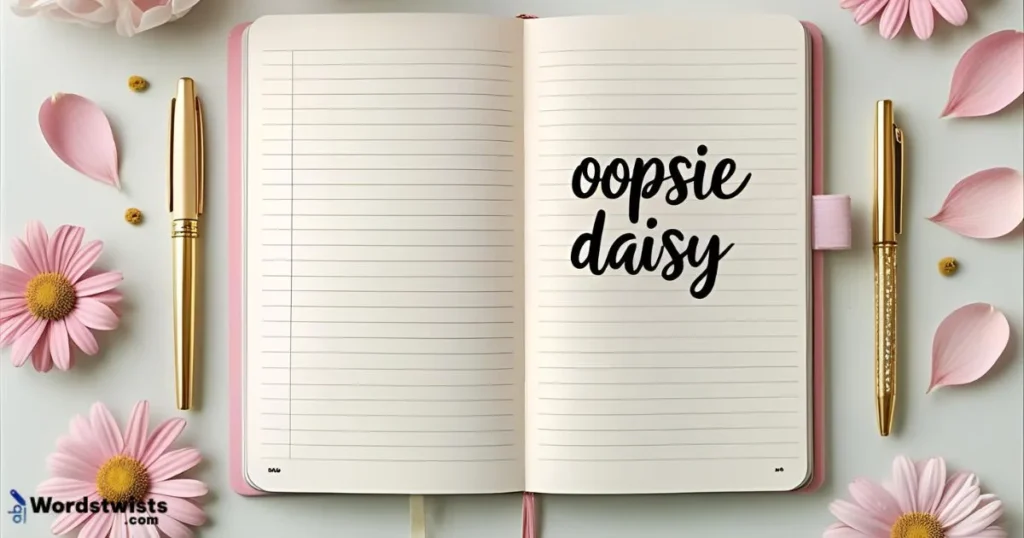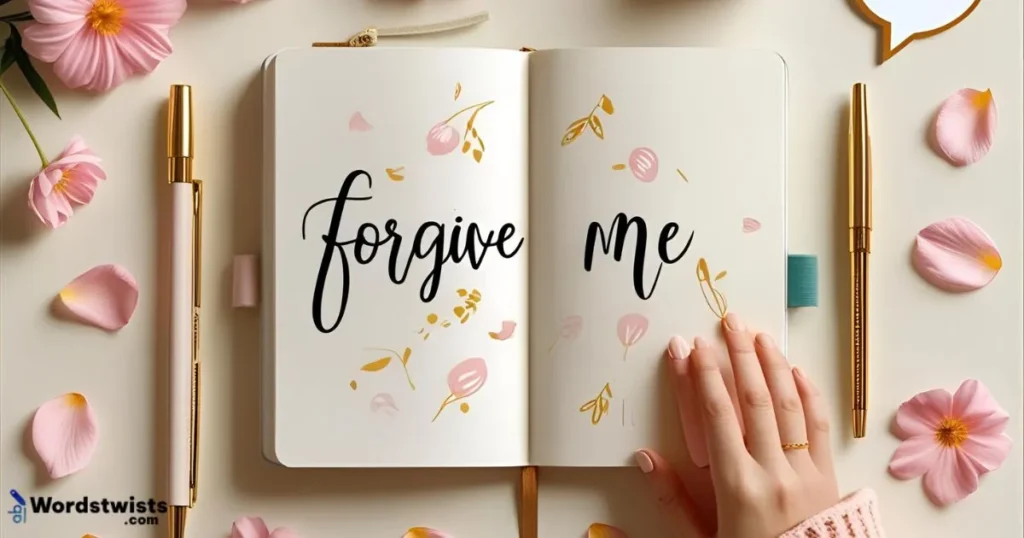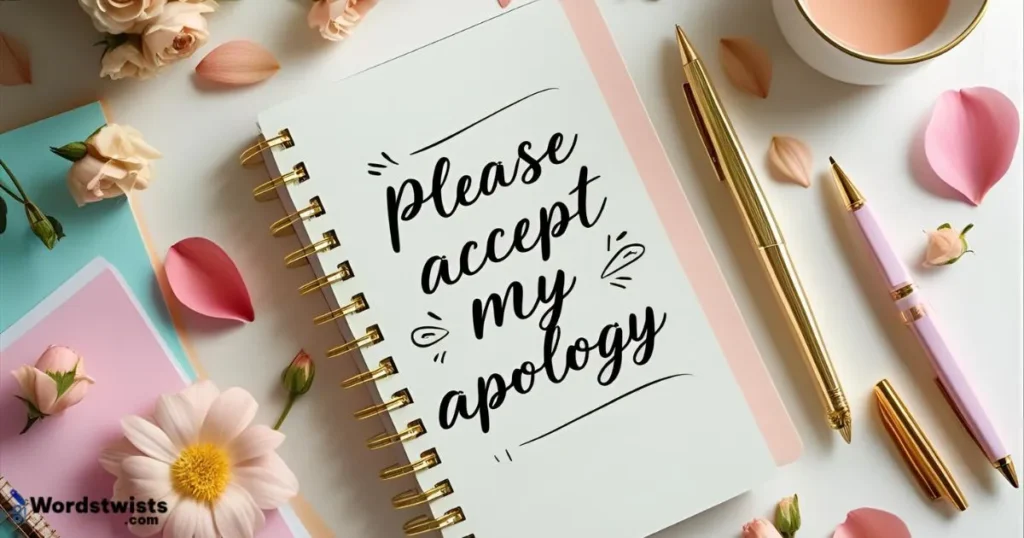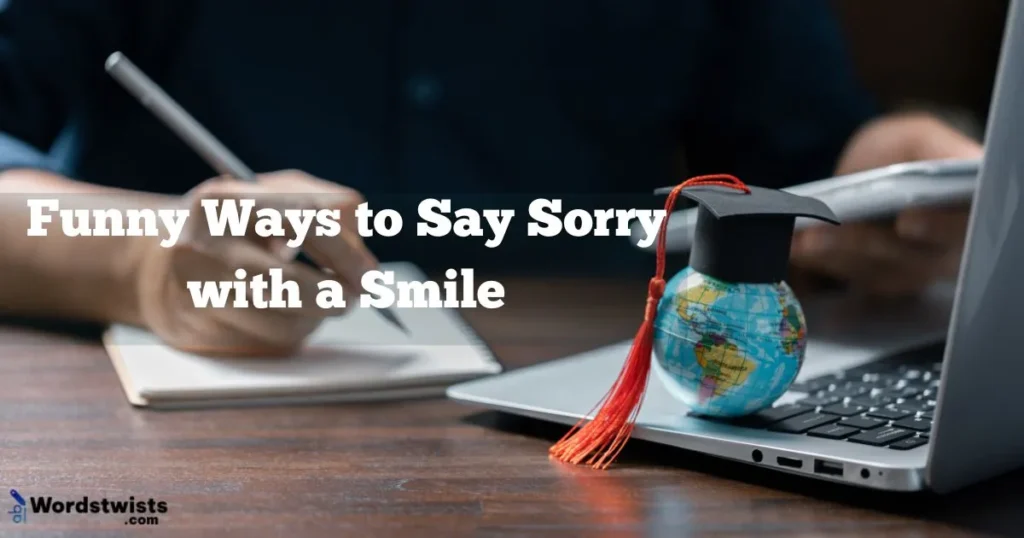Let’s face it — how many times have you caught yourself saying the same old phrase, “Funny ways to say sorry,” and felt like it just didn’t quite cut it anymore? Whether you’re sending an apology text, delivering a heartfelt speech, or simply trying to add some charm to your daily conversations, the classic “I’m sorry” or “funny ways to say sorry” can start to feel a little stale. That’s where the magic of alternative expressions comes in!
In this post, we’ll explore 21+ creative and fresh alternatives that will spice up your vocabulary, giving your apologies or lighthearted comments the flair they deserve. By using these funny alternatives and unique phrases, your communication will have more style, personality, and impact. Ready to ditch the repetition and discover new ways to express yourself? Let’s dive in!
Compelling Alternatives to “Funny Ways to Say Sorry”
1. My Bad
Explanation: A casual, yet effective way to acknowledge your mistake without sounding overly formal. It adds a sense of lightness to the apology.
Examples:
- “Oops, I missed your call! My bad, I was in the middle of something.”
- “My bad, I didn’t mean to step on your foot!”
- “Sorry I’m late to the party; my bad for losing track of time.”
- “My bad, I completely forgot about the meeting today.”
- “I didn’t mean to interrupt your speech, my bad!”
Why it Works: This phrase feels informal and fun, making it perfect for situations where you want to apologize without sounding too heavy or serious.
2. Oopsie Daisy

Explanation: A playful, lighthearted expression often used when a minor mistake is made. It brings a sense of whimsy to an apology.
Examples:
- “Oopsie daisy, I spilled coffee all over the table!”
- “Oopsie daisy, I accidentally deleted your file. Let me restore it!”
- “Oopsie daisy, I didn’t mean to surprise you like that!”
- “I was trying to be cool, but oopsie daisy, I tripped!”
- “Oopsie daisy, I forgot we had a meeting!”
Why it Works: It’s a cute and humorous way to apologize, perfect for minor, non-serious mistakes. It softens the impact of the error and can make the situation feel more relaxed.
3. My Apologies
Explanation: A more formal but still polite way of apologizing, showing sincerity without overcomplicating things.
Examples:
- “My apologies, I didn’t mean to offend you.”
- “My apologies, I wasn’t aware of the time.”
- “My apologies, I didn’t get the memo about the change in plans.”
- “My apologies, I forgot to confirm our meeting.”
- “My apologies for the confusion earlier; let me clarify.”
Why it Works: While still casual, it elevates the tone and makes the apology sound more respectful, making it great for both personal and professional use.
4. Whoops
Explanation: A quick, commonly used expression to acknowledge an unexpected mishap in a carefree manner.
Examples:
- “Whoops, I didn’t mean to bump into you like that.”
- “Whoops, I forgot to bring the dessert.”
- “Whoops, I spilled the milk all over the kitchen floor.”
- “Whoops, I didn’t realize the deadline was today.”
- “Whoops, I accidentally sent that message to the wrong person!”
Why it Works: It conveys light-heartedness and is often used in less serious situations, helping to defuse tension and make mistakes more acceptable.
5. Forgive Me

Explanation: A slightly more serious and heartfelt apology, often used when you’ve caused significant inconvenience or hurt.
Examples:
- “Forgive me, I didn’t mean to hurt your feelings.”
- “I’m really sorry, forgive me, I missed your special day.”
- “Forgive me for being so inconsiderate.”
- “Please, forgive me for the misunderstanding.”
- “Forgive me if I’ve been difficult to work with.”
Why it Works: It’s a straightforward but sincere way to seek forgiveness, especially in situations that call for genuine regret or a more thoughtful response.
6. I Messed Up
Explanation: A straightforward, relatable way to own up to a mistake without making it sound overly formal or exaggerated.
Examples:
- “I messed up, I forgot to send you the report.”
- “I messed up and sent the wrong files.”
- “I messed up the recipe, I hope it’s still edible!”
- “I messed up the surprise – didn’t mean for you to find out early.”
- “I messed up, I didn’t know the rules.”
Why it Works: It’s casual and relatable, making it ideal for everyday situations when you need to own up to a mistake without making it a big deal.
7. Mea Culpa
Explanation: A Latin phrase that translates to “my fault.” It’s a bit more formal but often used humorously to acknowledge a serious mistake.
Examples:
- “Mea culpa, I should have double-checked the details before sending that email.”
- “Mea culpa, I was late to the event.”
- “Mea culpa, I forgot to pick up your dry cleaning.”
- “Mea culpa, I got distracted and missed your call.”
- “Mea culpa, I didn’t realize you were waiting for me.”
Why it Works: It adds an air of sophistication and humor, making it a unique and thoughtful way to admit fault without sounding too casual.
8. Pardon Me
Explanation: A polite and sometimes formal expression used to apologize, often when you’ve interrupted or made a minor mistake.
Examples:
- “Pardon me, I didn’t mean to interrupt your conversation.”
- “Pardon me, but I think you dropped something.”
- “Pardon me, I didn’t realize I was in your way.”
- “Pardon me, I accidentally bumped into you.”
- “Pardon me, I forgot to mention something important.”
Why it Works: It’s a respectful and courteous way to apologize, ideal for formal or semi-formal settings. It shows you value the other person’s space or time.
Learn More: Funny Ways to Say “Goodnight Over Text”
9. I Owe You One
Explanation: A friendly and often humorous way to acknowledge a mistake, paired with an offer to make it up in the future.
Examples:
- “I owe you one for covering for me today.”
- “I owe you one; I’ll bring you lunch tomorrow to make up for this.”
- “I owe you one, sorry I didn’t reply sooner.”
- “I owe you one, thanks for being so understanding.”
- “I owe you one, let’s plan something fun soon to make up for it.”
Why it Works: This phrase conveys a sense of camaraderie and promises to make up for the mistake, making it more of a good-natured apology than a formal one.
10. I Didn’t Mean That
Explanation: A simple yet powerful way to express regret when your words or actions may have unintentionally offended someone.
Examples:
- “I didn’t mean that, I was just joking around.”
- “I didn’t mean to come out the wrong way.”
- “I didn’t mean that, I was stressed and didn’t think before speaking.”
- “I didn’t mean that; I’m really sorry if it sounded rude.”
- “I didn’t mean that, it was a thoughtless comment.”
Why it Works: It shows awareness and genuine regret for something you didn’t intend, which can help smooth over misunderstandings and prevent hurt feelings.
11. Please Accept My Apology

Explanation: A more formal and respectful way to apologize, often used in written communication or when addressing someone of higher authority.
Examples:
- “Please accept my apology for missing your birthday celebration.”
- “Please accept my apology for the confusion earlier.”
- “Please accept my apology for not responding to your email sooner.”
- “Please accept my apology, I made an error in the report.”
- “Please accept my apology for any inconvenience caused.”
Why it Works: It conveys sincerity and respect, making it appropriate for both professional and personal situations where a more formal tone is required.
12. It Wasn’t Meant to Be
Explanation: A way to convey that a mistake or situation wasn’t intentional, often used in a more philosophical or reflective tone.
Examples:
- “It wasn’t meant to be, I missed the flight, but I’ll catch the next one.”
- “It wasn’t meant to be, I didn’t get the promotion, but there’s always next time.”
- “It wasn’t meant to be, I made a mistake, but I’ll learn from it.”
- “It wasn’t meant to be, I apologize for the delay.”
- “It wasn’t meant to be that I forgot your anniversary, I’ll make it up to you.”
Why it Works: It introduces a reflective element, suggesting that things happened for a reason while still acknowledging the mistake. It’s a soft approach that can be especially effective in difficult situations.
13. I’m at Fault
Explanation: A straightforward admission of responsibility, this expression is used when you want to take full accountability for your actions.
Examples:
- “I’m at fault for the mix-up, and I’ll take care of it.”
- “I’m at fault for not checking the details before sending the report.”
- “I’m at fault for being late, I should have planned better.”
- “I’m at fault for the confusion. Let’s work together to clear it up.”
- “I’m at fault, and I apologize for any inconvenience I caused.”
Why it Works: It’s a direct and no-nonsense way to apologize, clearly showing accountability and honesty. It works well in both personal and professional settings where clarity is important.
14. I’m Sorry, I Goofed
Explanation: A playful and self-deprecating way to admit a mistake, often used to diffuse tension and add a bit of humor.
Examples:
- “I’m sorry, I goofed on that report – I’ll fix it right away.”
- “I’m sorry, I goofed by forgetting our meeting.”
- “I’m sorry, I goofed, I was distracted and missed the deadline.”
- “I’m sorry, I goofed, I should have read the instructions carefully.”
- “I’m sorry, I goofed, I mixed up the dates.”
Why it Works: It introduces a sense of humor and humility, making it easier for others to forgive minor mistakes without feeling burdened by a formal apology. It lightens the mood and shows you’re not taking yourself too seriously.
15. I Wasn’t Thinking
Explanation: A humble admission of a mistake, often used when you acted impulsively or without considering the consequences.
Examples:
- “I wasn’t thinking when I said that; please forgive me.”
- “I wasn’t thinking when I agreed to too many tasks.”
- “I wasn’t thinking, and I made a rash decision.”
- “I wasn’t thinking clearly when I responded the way I did.”
- “I wasn’t thinking when I walked out, I should have stayed to talk.”
Why it Works: This phrase conveys self-awareness and implies that your actions were not intentional, which helps others understand your mistake without feeling offended. It’s often effective in sensitive situations.
16. My Bad
Explanation: A casual, informal way to acknowledge a mistake, often used among friends or in less formal situations. It’s short and to the point, without much ceremony.
Examples:
- “My bad for missing the meeting – I completely lost track of time.”
- “My bad, I didn’t mean to spill that drink.”
- “My bad, I didn’t hear you the first time.”
- “My bad, I should’ve been more careful with that.”
- “My bad, I forgot to bring the documents you asked for.”
Why it Works: It’s a laid-back and easygoing way to admit a mistake without creating unnecessary tension. It’s best for informal settings, where humor and familiarity are appreciated.
Read More: Funny Ways to Say “It’s Hot”
17. I Should Have Known Better
Explanation: This phrase is used when you realize that your actions or behavior were misguided, and you acknowledge that you should have acted more wisely.
Examples:
- “I should have known better than to skip breakfast.”
- “I should have known better than to trust that my colleague would finish the task.”
- “I should have known better than to make that decision without thinking it through.”
- “I should have known better, I should have checked the facts before responding.”
- “I should have known better, I let my frustration take over.”
Why it Works: It conveys self-reflection and regret, showing that you acknowledge your mistake and the lesson learned. It can demonstrate growth, which makes it more sincere and thoughtful.
18. I Regret That
Explanation: A more formal way to express remorse, typically used when something has been said or done that you truly wish you could take back.
Examples:
- “I regret that I couldn’t make it to your event.”
- “I regret that I didn’t support you when you needed it most.”
- “I regret that I made that decision without consulting you first.”
- “I regret that we didn’t have more time to talk.”
- “I regret that I wasn’t more careful with my words.”
Why it Works: It’s a sophisticated way to apologize, expressing deep regret and making it clear that you understand the gravity of your actions. This works well in professional or formal situations.
Read More: Funny Ways to Say “I’m Hungry”and Need Food
19. I Hope You Can Forgive Me
Explanation: A slightly more vulnerable way of apologizing, showing that you’re uncertain but hoping the other person can find it in themselves to forgive you.
Examples:
- “I hope you can forgive me for the misunderstanding earlier.”
- “I hope you can forgive me, I know I hurt your feelings.”
- “I hope you can forgive me, I didn’t mean to let you down.”
- “I hope you can forgive me, I was out of line.”
- “I hope you can forgive me, I know I could have done better.”
Why it Works: It expresses humility and a desire to make things right, which can often soften the other person’s reaction. It is an effective way to show genuine remorse without pressuring the other person to forgive you immediately.
20. I Apologize for That
Explanation: A straightforward and classic phrase to express regret and acknowledge a mistake, often used in formal situations or when you need to make a clear and direct apology.
Examples:
- “I apologize for that, I didn’t mean to interrupt your speech.”
- “I apologize for that, I was out of line.”
- “I apologize for that, I should have been more mindful of your time.”
- “I apologize for that, it won’t happen again.”
- “I apologize for that mistake; it was completely my fault.”
Why it Works: It’s clear and unambiguous, perfect for professional settings where you need to express your regret without the need for further elaboration. It’s a reliable option when sincerity and clarity matter.
21. That Was Thoughtless of Me
Explanation: This phrase reflects a self-aware apology, acknowledging that you acted without careful consideration or empathy for the other person.
Examples:
- “That was thoughtless of me, I should have asked how you were doing first.”
- “That was thoughtless of me, I shouldn’t have made that comment.”
- “That was thoughtless of me, I didn’t think about how it might affect you.”
- “That was thoughtless of me, I should have taken the time to understand the situation better.”
- “That was thoughtless of me, I wasn’t thinking when I did that.”
Why it Works: It conveys a sense of reflection and shows that you’re aware of how your actions may have impacted the other person, making it more personal and empathetic.
22. I Didn’t Mean to Offend
Explanation: This phrase is used to clarify that any offense caused was unintentional, often used when the other person has taken offense to something you said or did.
Examples:
- “I didn’t mean to offend, I was just joking around.”
- “I didn’t mean to offend, that wasn’t my intention.”
- “I didn’t mean to offend, I was trying to be funny.”
- “I didn’t mean to offend, I didn’t realize how my words would come across.”
- “I didn’t mean to offend, I was just being honest.”
Why it Works: It provides clarity and shows intent behind your actions. It’s particularly useful when you want to avoid misunderstandings or any unnecessary hurt feelings.
23. I Didn’t Think That Through
Explanation: A way of admitting that you acted impulsively without fully considering the consequences, which can be an effective apology when you make a snap decision that didn’t work out well.
Examples:
- “I didn’t think that through, I apologize for the mistake.”
- “I didn’t think that through, I should have checked with you first.”
- “I didn’t think that through, and now I see where I went wrong.”
- “I didn’t think that through, I should have taken more time to plan.”
- “I didn’t think that through, I realize now how it impacted you.”
Why it Works: It conveys self-awareness and the recognition that a lack of consideration led to a mistake, which makes your apology more meaningful.
24. I Got It Wrong
Explanation: A simple yet effective way of acknowledging a mistake without overcomplicating the apology.
Examples:
- “I got it wrong, I should have followed up earlier.”
- “I got it wrong, I didn’t understand the instructions.”
- “I got it wrong, I mixed up the dates for the meeting.”
- “I got it wrong, I should have been more careful with my words.”
- “I got it wrong, I didn’t see the full picture.”
Why it Works: This phrase is clear and concise, providing a no-fuss way to admit your mistake. It works well in both casual and professional settings where you want to quickly take responsibility for an error.
25. I Should Have Handled That Better
Explanation: An honest and reflective apology that acknowledges you could have managed a situation more appropriately.
Examples:
- “I should have handled that better, I apologize for how I responded.”
- “I should have handled that better, I didn’t realize it was such a sensitive topic.”
- “I should have handled that better, I regret how things went down.”
- “I should have handled that better, I was too quick to judge.”
- “I should have handled that better, I wasn’t thinking clearly.”
Why it Works: This phrase is useful because it emphasizes growth and learning from your mistakes. It shows that you’re willing to improve and take accountability for your actions.
Conclusion
Using these 21+ alternatives to “Funny ways to say sorry“ can instantly elevate your communication. Whether you’re looking for something more formal, casual, or creative, there’s a perfect way for you to express your apology in a way that feels authentic and impactful.
So, next time you need to apologize, skip the generic phrases and choose one that reflects your personality and sincerity. Start exploring these alternatives and watch how your vocabulary grows, making your conversations and writing more dynamic and engaging!

I’m Leo Knox, the wordplay wizard behind WordsTwists.com where I turn everyday meanings into funny, clever, and creative twists. If you’re tired of saying things the boring way, I’ve got a better (and funnier) one for you!


